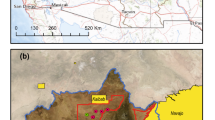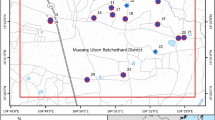Abstract
In May 2004, two groundwater wells in Dinwiddie County, Virginia were found to have natural uranium levels either at or above the EPA recommended limit of 30 μg/l. As a result, a stop drinking water advisory was issued until a water treatment system could be installed to remove the uranium. In response to residents' concerns, and uncertainty of exposures, affected individuals were asked to participate in a voluntary epidemiological investigation of uranium uptake and 1-year uranium retention study. This study had two primary objectives: quantification of the uranium load on the participants, as expressed by their urine uranium concentration, and retention after 1 year of no exposure. A first-morning void urine specimen, along with survey information, was collected from 156 participants in May 2004, with a second collection occurring 12 months later of 91 participants. The samples were analyzed for uranium by ICP/MS, pH, creatinine by the Jaffe method, and RBP by LIA after both collections. A reduction of one order of magnitude for the geometric mean urine uranium concentration was observed, from 0.100 μg/g creatinine to 0.011 μg/g creatinine in 1 year. Comparatively, NHANES has reported that the geometric mean for all participants, ages 6 years and older, is 0.008 μg/g creatinine, with the 95th percentile being 0.040 μg/g creatinine. None of the second round specimens showed a urine uranium concentration higher than baseline for an individual.
This is a preview of subscription content, access via your institution
Access options
Subscribe to this journal
Receive 6 print issues and online access
$259.00 per year
only $43.17 per issue
Buy this article
- Purchase on Springer Link
- Instant access to full article PDF
Prices may be subject to local taxes which are calculated during checkout

Similar content being viewed by others
References
Al-Jundi J., Werner E., Roth P., Höllriegl V., Wendler I., and Schramel P. Thorium and uranium contents in human urine: influence of age and residential area. J Environ Radioact 2004: 71: 61–70.
Bernard A.m., Moreau D., and Lauwerys R. Comparison of retinol-binding protein and beta 2-microglobulin determination in urine for the early detection of tubular proteinuria. Clin Chim Acta 1982: 126: 1–7.
Centers for Disease Control and Prevention. Third National Report on Human Exposure to Environmental Chemicals. Centers for Disease Control and Prevention, CDC, Atlanta, GA, 2001–2002.
Kim Y., Park J., Kim J., Park S., Cho B., Sung I., and Shin D. Health risk assessment for uranium in Korean groundwater. J Environ Radioact 2004: 77: 77–85.
Kurttio P., Auvinen A., Salonen L., Saha J., Pekkanen J., Mäkeläinen I., et al. Renal effects of uranium in drinking water. Environ Health Perspect 2002: 110 (4): 337–342.
Orloff K., Mistry K., Charp P., Metcalf S., Marino R., Shelly T., et al. Human exposure to uranium in groundwater. Environ Res 2004: 94: 319–326.
Seaton B., and Ali A. . Simplified manual high performance clinical chemistry methods for developing countries. Med Lab Sci 1984: 41: 327–336.
Slot C. . Plasma creatinine determination. A new and specific Jaffe reaction method. Scand J Clin Lab Invest 1965: 17: 381–387.
US Department of Health and Human Services. Health Consultation: Follow-up Exposure Investigation Retinol Binding Protein Analysis. USDHHS, Simpsonville/Fountain Inn., Atlanta, GA, 2002.
Acknowledgements
We thank and appreciate to the Virginia Department of Health for sample collection and assistance in epidemiological analysis of all data collected. Additional guidance in these areas was provided by Steven G Inserra of the National Center for Environmental Health/Agency for Toxic Substances and Disease Registry. We also acknowledge the Catholic University of Louvain, Department of Industrial Toxicology and Occupational Medicine, for determinations of retinol-binding protein and creatinine. Michael Royster would also like to thank the advisory committee of community residents that provided input into the design and administration of the survey, and the collection and reporting of urinary samples to the community as a whole. This committee included Ken Burchett, Frankie Franck, Betty Haney, Jack Huett, Susan Huett, Eva O'Conner, and Calvin Robb.
Author information
Authors and Affiliations
Corresponding author
Appendices
Appendix A












Appendix B


Rights and permissions
About this article
Cite this article
Wyatt, S., Reitz, L., Croley, T. et al. Biological monitoring of uranium exposure in south central Virginia. J Expo Sci Environ Epidemiol 18, 59–75 (2008). https://doi.org/10.1038/sj.jes.7500616
Received:
Accepted:
Published:
Issue Date:
DOI: https://doi.org/10.1038/sj.jes.7500616
Keywords
This article is cited by
-
Biomonitoring for uranium exposure among young children living in nineteen states across five regions of Brazil
Journal of Radioanalytical and Nuclear Chemistry (2018)



